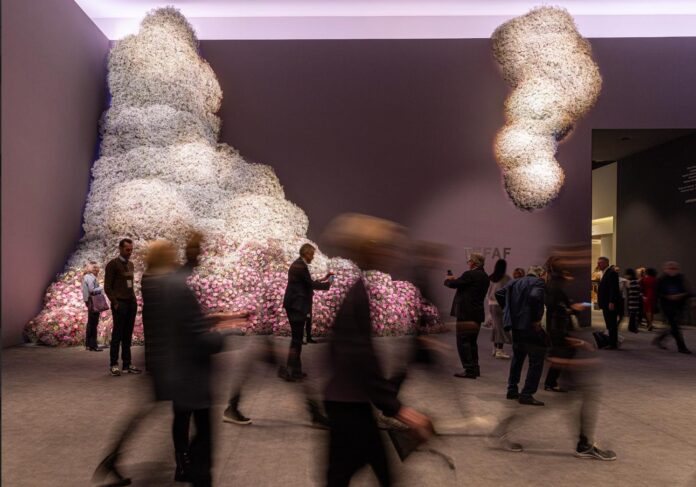Old Masters are a hard sell. “This is not a business for the faint-hearted. Or those in a rush,” said Carlo Milano, the founder of the London gallery Callisto Fine Arts, which opened in 2012.
Speaking last week at the opening of the 36th edition of Tefaf Maastricht, where Milano is exhibiting for the first time, in the Showcase section for galleries under ten years old, the dealer said the “mood was right”, though sales were proving elusive on the opening day (prices range from €7,500 to €175,000). Unlike at contemporary art fairs, pre-selling is generally frowned upon at Tefaf.
“Some of my things have taken eight years to sell—but what’s eight years when you’re dealing with 500 years of history?” Milano added.
Another newcomer to the fair, Will Elliott of Elliott Fine Art, had sold three works within the first few hours, including a picture of a young bride from Bethlehem, by the 19th-century Belgian painter Albrecht de Vriendt, which went for €120,000 to a US museum. He noted how institutions are “looking to diversify their collections” by acquiring works of non-white sitters. “This area of the market is much more present than it was even two to three years ago,” Elliott said.
Change is slowly beginning to happen among private buyers, too, according to some dealers. “Typically, the Old Masters collector is of a certain age, male, European. We are beginning to see a new generation, [who are] younger and with a different approach,” Milano said. “The type of collector who focuses on a specific school or artist is being replaced by a new type—younger collectors who like the image and the story it tells.” This year, the Frick Museum brought 15 patrons aged under 40 to the fair in a bid to encourage them to collect. Other museums in attendance included the Musée d’Orsay, the Uffizi Galleries and the Minneapolis Institute of Art.
The veteran British dealer Nicholas Hall noted how a growing pool of elusive cross-over collectors are being influenced by fashion designers such as Jonathan Anderson, Raf Simons and Vivienne Westwood, who have all appropriated Old Master motifs. Non-traditional collectors, he added, are attracted to “weird subject matter”, such as Hieronymus Bosch’s fantastical landscapes, skulls and witches, as well as “modernistic still lifes”—particularly 17th-century Dutch and Spanish pictures—portraits which are “direct and challenging” and works by “the very big names: Leonardo, Rembrandt etc”.
On the opening day of Tefaf, Hall reported selling a work by the German Baroque painter Johann Carl Loth for “under $500,000” to a European collector, who—along with those from the East Coast of the US—remain the main drivers in the Old Master market.
Hall said he has tried to put a “more contemporary twist” on his presentation at the fair this year, though he added that while “Old Master pictures look great with contemporary and Modern works, they don’t thrive in a white cube.” In 2018, Hall collaborated with the contemporary dealer David Zwirner on an exhibition titled Endless Enigma: Eight Centuries of Fantastic Art. Among the works Hall sold were a late Titian, to a contemporary buyer, as well as several pieces of Mediaeval sculpture and a Goya drawing. Future collaborations are reported to be in the pipeline. Hall would appear in good company. Last week, the Financial Times reported that the contemporary Saatchi Yates galley is launching an Old Masters division.
There are ways, of course, of making new discoveries in old art. At Tefaf, the British dealer Stuart Lochhead is showing works by two 19th-century sculptors, Félicie de Fauveau and Charlotte Besnard, two women artists “who have long been denied their place in the canon of art history”, according to the gallery. Lochhead noted that museums are “particularly interested in filling the gaps in their collections”, while stressing that “an artist has to be a good artist before anything else”. De Fauveau’s marble portrait of King Henry V sold on the second day of the fair to a US institution, priced “in the region of $170,000”.
Supply of the very best works is the perennial issue for Old Master dealers and big-ticket sales were not much in evidence at the fair. One of the highest value sales reported on the opening day, on Lochhead’s stand, was a sculpture by Barthélemy Prieur, Lion Devouring a Doe, which sold for around £1.4m.
Though considerable by most people’s standards, the sum pales in comparison with the prices being achieved for contemporary art. Indeed, in 2021, European Old Masters represented just 4% of fine-art auction sales, a figure dwarfed by the 45% share claimed by post-war and contemporary art.
Several dealers pointed out the comparison is a moot point, given that the type of collector involved in the contemporary art market is more concerned with investment than “the values of beauty, quality, and rarity”, as the Italian dealer Antonacci Lapiccirella puts it. Within two days of the fair opening, she sold Giacomo Balla’s The Four Seasons (1940) to a private European collector for around €1m.
From the point of view of the public, “there is no shortage of interest in Old Master paintings”, said the British dealer Charles Beddington. Indeed, one just has to look at the fact that the Vermeer exhibition at the Rijksmuseum sold out almost immediately, while there are routinely queues to get into the Prado in Madrid or the Louvre in Paris.
In time, dealers hope this interest will trickle down to the market. “I think that there is an increasing feeling that Old Master paintings are undervalued compared with just about everything else, not only contemporary art but also sculpture and drawings,” Beddington said.

























